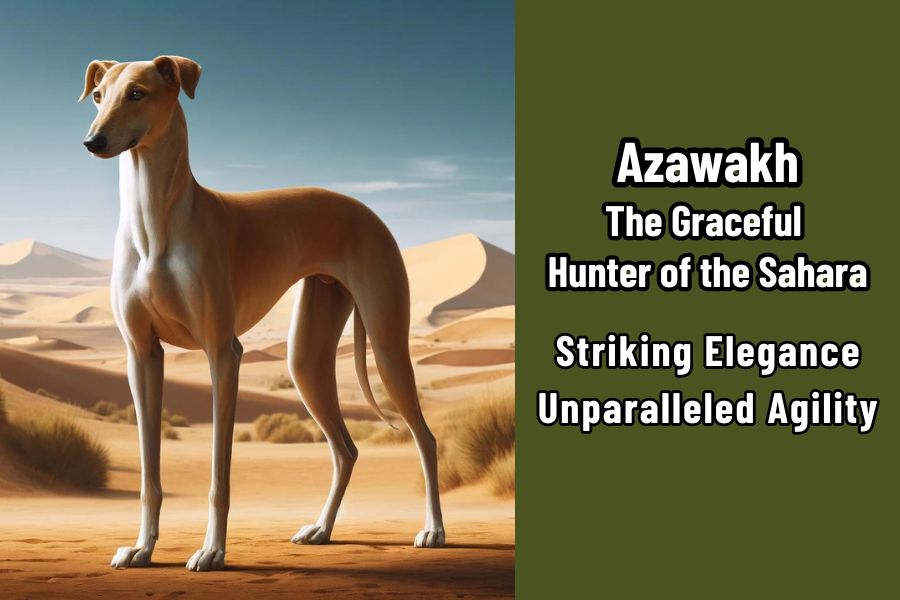Discover Sahara’s graceful hunter, the Azawakh. Learn about their rich history, hunting roles, unique traits, and why they are considered a threatened breed.
Introduction
Imagine a dog that embodies both the grace of a gazelle and the tenacity of a hunter. The Azawakh, a breed steeped in the mystique of the Sahara, is just that. Its lean, elegant frame and fierce loyalty captivate dog enthusiasts worldwide.
Whether you’re a hunter, a dog lover, or simply curious about this rare breed, you’ll find valuable insights here. Let’s begin and discover why the Azawakh sighthound stands out among hunting dogs.
Azawakh Origin and History
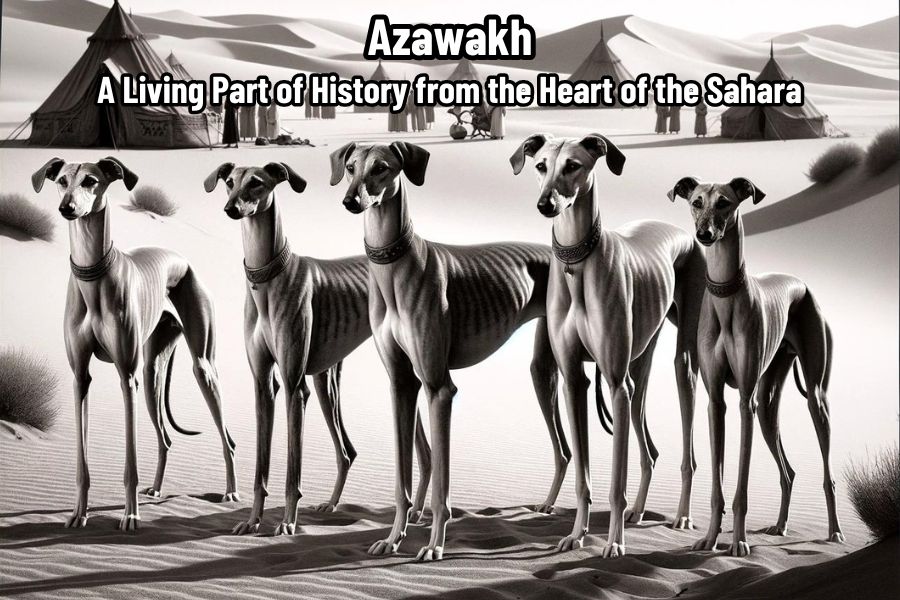
The Azawakh is more than just a dog; it’s a living piece of history from the heart of the Sahara. Known for its striking elegance and unparalleled agility, the Azawakh has a rich heritage that stretches back centuries, embodying the spirit and resilience of the nomadic tribes who treasured them.
Ancestors
The origins of the Azawakh trace back over a thousand years to the nomadic Tuareg tribes of the Sahel region, encompassing Mali, Niger, and Burkina Faso. Bred primarily for hunting and guarding, their lineage includes ancient sighthounds that were prized for their speed, endurance, and loyalty. Interesting fact: these dogs were often considered family members, treated with the same respect and care as any other tribal member.
Evolution
Throughout history, the Azawakh evolved to adapt to the harsh desert conditions. By the 20th century, these dogs had established themselves as proficient hunters of gazelle and hare, known for their ability to cover vast distances with ease. Their introduction to Europe in the 1970s marked a significant milestone, bringing this noble breed into the international spotlight. Intriguing fact: despite their relatively recent introduction to the West, this rare breed has maintained their genetic purity, thanks to the careful breeding practices of the Tuareg.
Breed Status
Today, the Azawakh is considered a “threatened” breed, with an estimated population of only 150 in the United States and less than 3,000 worldwide. This status highlights the need for dedicated breeding programs and increased awareness to preserve this unique breed’s legacy.
Kennel Clubs
The Azawakh has garnered recognition from several major kennel clubs around the world:
- American Kennel Club (AKC) – Recognized in 2019
- United Kennel Club (UKC) – Recognized in 1993
- The Kennel Club (TKC) – Recognized in 2015
- Canadian Kennel Club (CKC) – Recognition is in progress
These recognitions are a testament to the breed’s growing popularity and the efforts of enthusiasts dedicated to its preservation.
Azawakh In Action
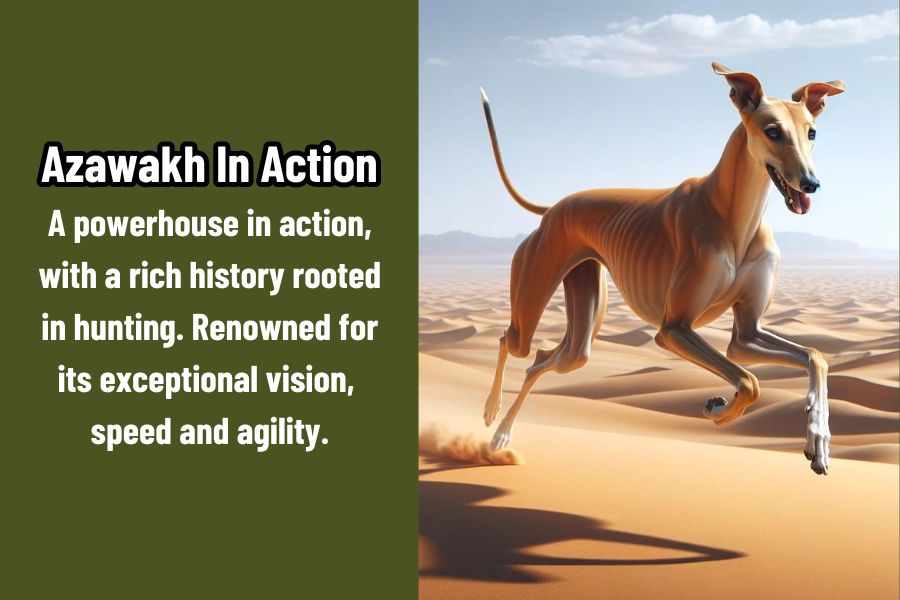
The Azawakh is not just a strikingly beautiful dog; it’s a powerhouse in action. With a history rooted in hunting and guarding, these dogs are both agile hunters and vigilant protectors, showcasing their incredible versatility and instinctive abilities.
Hunting
The Azawakh is a true sighthound, renowned for its exceptional vision, speed and agility. Primarily, they pursue swift prey such as gazelle and hare across the expansive desert landscapes Unlike many sighthounds that hunt solo, the Azawakh often hunts in packs, demonstrating remarkable coordination and teamwork. The packs include very sophisticated social hierarchies.
Once the Azawakh locates its prey, the chase begins. These dogs can reach speeds of up to 40 mph, making them one of the fastest breeds. They use their long, powerful legs to cover ground rapidly, their sharp eyes locked on the target. As the prey tires, the Azawakh strategically bumps it with its hindquarters, knocking it off balance and making the final capture.
Guard Dog
The Azawakh also excels as a guard dog, a role they have played for centuries. If one of the dogs in the pack senses danger, it will alert the rest of the pack with a sharp bark. The pack, led by the alpha dog, quickly assembles, ready to confront the threat. Whether it’s chasing off intruders or defending against predators, their courage and pack mentality make them formidable guardians.
Azawakh Physical Traits
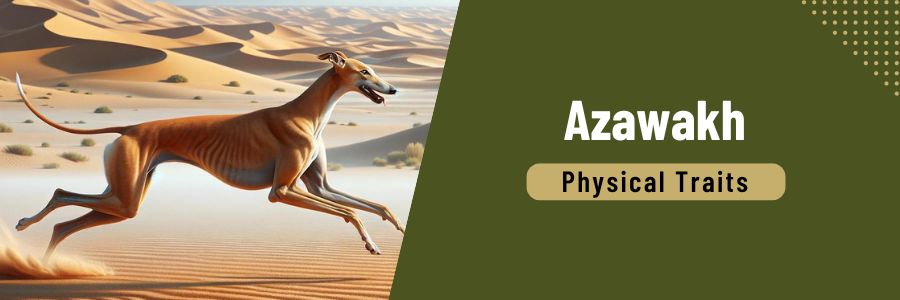
The Azawakh is a marvel of nature, with physical traits that reflect its origin and purpose. Every aspect of this breed, from its lean frame to its distinctive gait, speaks to its role as a hunter and guardian in the harsh Sahara environment.
Size (Length and Height)
Azawakhs are slender and tall, with males typically standing between 25 to 29 inches at the shoulder and females slightly smaller at 23 to 27 inches. Their length, measured from the point of the shoulder to the point of the buttocks, often mirrors their height, giving them a balanced, square profile.
Head and Muzzle
The Azawakh has a long, narrow head that tapers to a fine, elegant muzzle. Their almond-shaped eyes are set deep and have an alert, intelligent expression. The ears are set high and fold down, enhancing their regal appearance.
Body Structure and Weight
The body of the Azawakh is lean and muscular, designed for speed and endurance. Males typically weigh between 44 to 55 pounds, while females are lighter, ranging from 33 to 44 pounds. Their ribs are prominently visible, which is normal for this breed and indicative of their lightweight build necessary for agility and swiftness.
Coat Type and Colors
Azawakhs have a short, fine coat that can come in a variety of colors including sand, fawn, brindle, blue, black, and even red. Some of these dogs may also have white markings on their legs, chest, and tail tip. This thin coat reflects their adaptation to the hot, arid climates of their native regions.
Keen Senses
Azawakhs possess highly developed senses that make them exceptional hunters and guardians. Their sharp eyesight allows them to spot prey from great distances, while their acute hearing helps detect any potential threats long before they become visible.
Tail Structure and Purpose
The tail of the Azawakh is long, thin, and slightly curved at the tip. It serves as a balancing tool during high-speed chases and helps communicate the dog’s emotional state, whether it’s alertness, excitement, or relaxation.
Gait and Speed
The gait of the Azawakh is a sight to behold. They move with a fluid, effortless grace, covering ground with long, efficient strides. This breed can reach speeds of up to 40 mph, making them one of the fastest dog breeds in the world.
Life Expectancy
Azawakhs generally have a life expectancy of 10 to 12 years, which is typical for breeds of their size and activity level. With proper care, some can live even longer, enjoying a healthy, active life.
Gestation Period and Litter Size
The gestation period for an Azawakh is approximately 63 days, similar to most dog breeds. They typically have litters ranging from 4 to 6 puppies, although larger litters are not uncommon.
Azawakh Behavioral Traits
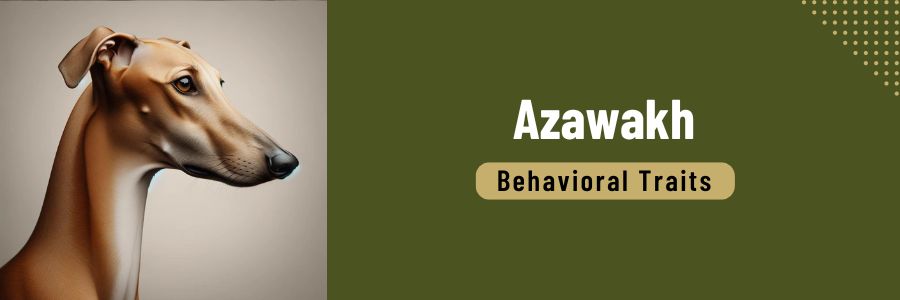
The Azawakh is a breed of remarkable behavioral traits that make it both a fascinating and challenging companion. Their unique behaviors are deeply rooted in their history and purpose, reflecting a blend of independence and loyalty.
Prey Drive
Azawakhs have a strong prey drive, a trait honed over centuries of hunting in the Sahara. Their instinct to chase is powerful, and they are known for their speed and agility in pursuing prey. This prey drive makes them exceptional hunters but requires careful management to ensure they don’t chase smaller pets or wildlife.
Intelligence
The Azawakh is highly intelligent, often displaying a keen understanding of their surroundings and a quick ability to learn. This intelligence, combined with their independent nature, means they can solve problems on their own but may also exhibit a stubborn streak. Owners must be patient and consistent in their training approach.
Versatility
Azawakhs are versatile dogs, capable of excelling in various roles from hunting to guarding and even participating in dog sports. Their agility and speed make them excellent competitors in lure coursing, while their protective instincts shine in guarding roles.
Temperament
The temperament of an Azawakh is a unique blend of aloofness and affection. They are typically reserved around strangers but can be incredibly affectionate and loyal to their family. This breed tends to be calm and composed but can display bursts of playful energy.
Trainability
Training an Azawakh requires patience and consistency. They are intelligent but can be independent, making them somewhat challenging to train. Positive reinforcement methods work best, encouraging them with treats and praise. Early socialization and training are crucial to help them become well-rounded adults.
Loyalty and Protective
Azawakhs are fiercely loyal and protective of their families. They are known to form strong bonds with their owners and can be very protective of their home and loved ones. This protective nature makes them excellent watchdogs, alerting their owners to any potential threats.
Family Compatibility
While Azawakhs are known for their loyalty, they are also sensitive dogs that thrive in a loving environment. They can be great family pets, especially in households that understand their need for exercise and mental stimulation. However, their high prey drive means they may not be the best fit for families with small pets.
Caring for your Azawakh

Caring for an Azawakh involves meeting their specific needs to ensure they thrive both physically and emotionally. From nutrition to exercise, understanding what makes this breed unique will help you provide the best care possible.
Nutrition
Given their athletic nature, Azawakhs require a diet rich in high-quality proteins and fats to maintain their lean muscle mass and energy levels. Look for dog foods that list meat as the first ingredient, supplemented with healthy fats like fish oil. Feeding them smaller, frequent meals can help sustain their energy throughout the day. Always ensure they have access to fresh water, especially after exercise.
Healthcare
Regular health check-ups are crucial for maintaining your Azawakh’s well-being. Common health issues include hip dysplasia, autoimmune diseases, and hypothyroidism. Routine vet visits can help detect these issues early and manage them effectively. Additionally, keeping up with vaccinations and preventative care, such as flea and tick treatments, is essential.
Grooming
While Azawakhs have short coats that require minimal grooming, regular brushing can help keep their skin healthy and free of debris. It’s important to check for skin infections, eye infections, flea infestations, ticks, and ear mites regularly. Maintaining their paws and nails is also crucial to prevent injuries and ensure they stay active and comfortable.
Exercise
Azawakhs are active dogs that need plenty of exercise to stay healthy. Regular physical activity helps prevent obesity, reduces the risk of joint issues, and keeps their heart in top condition. Without adequate exercise, they can become bored and anxious, leading to destructive behavior. Daily runs, play sessions, and mental stimulation are key to keeping them happy and well-adjusted.
Bonding
Building a strong bond with your Azawakh is essential for their emotional well-being. Spend quality time with them, engage in activities they enjoy, and provide consistent training and positive reinforcement. This not only strengthens your relationship but also helps them feel secure and loved, which is vital for their overall happiness.
Azawakh Training Tips
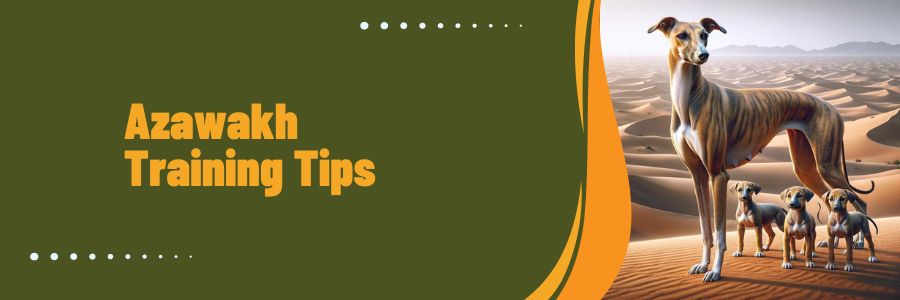
Training an Azawakh can be a rewarding experience, provided you understand their unique temperament and instincts. Whether you’re starting with a puppy or working with an adult dog, these tips will help you bring out the best in your Azawakh.
Puppy Training Tips
Starting training early with your Azawakh puppy is crucial. Given their high intelligence and strong prey drive, begin with basic commands like sit, stay, and come. Socialization is key; expose your puppy to various environments, people, and other animals to build their confidence and adaptability. For hunting training, introduce scents and sights of common prey like hare and gazelle gradually. Short, positive sessions that make use of treats and praise will keep your puppy engaged and eager to learn. Consistency, positive reinforcement and patience are your best tools at this stage.
Advanced Training Tips
As your Azawakh matures, you can start focusing on more advanced training techniques to refine their hunting skills. Use lure coursing to simulate the chase and build their speed and agility. Advanced obedience training is also essential; commands like heel, down, and off-leash recall are vital for controlling this breed in hunting situations. Incorporate scent tracking exercises to enhance their natural abilities and make sure to vary the training scenarios to mimic real hunting conditions. Because of their independent streak they respond best using positive reinforcement training.
Conclusion
The Azawakh is a remarkable breed, known for its grace, agility, and loyalty. We’ve explored its rich history, impressive hunting and guarding abilities, distinct physical and behavioral traits, and essential care and training tips.
Whether you are captivated by their elegance or intrigued by their storied past, they stand out as a unique and fascinating breed.
Embrace the journey of owning an Azawakh—you’ll discover one of the best hunting hounds, a loyal, intelligent, and spirited friend for life.
FAQs: Azawakh
What is a sighthound?
A sighthound is a type of dog that hunts primarily by sight and speed rather than scent and endurance. Known for their keen vision and swift running abilities, sighthounds are built for detecting and chasing down prey over vast distances. The Azawakh is a prime example of this, utilizing its incredible eyesight and agility to hunt in the harsh Sahara desert.
What is the origin of the Azawakh dog?
They hail from the Sahel region of Africa, specifically the areas around Mali, Niger, and Burkina Faso. They were bred by the nomadic Tuareg tribes for hunting and guarding livestock. These dogs have been companions and protectors for over a thousand years, embodying the culture and resilience of the Tuareg people.
Are Azawakh dogs rare?
Yes, these dogs are considered rare. With an estimated population of only 150 in the United States and fewer than 3,000 worldwide, they are classified as a “threatened” breed. Their rarity is a result of their specialized breeding and the limited number of breeders dedicated to preserving this unique breed.
Are Azawakh dogs easy to train?
They are are intelligent but can be independent and stubborn, making training a bit challenging. They respond best to positive reinforcement and require consistent, patient training. Early socialization and training are crucial to ensure they develop into well-rounded adults. Their intelligence and sensitivity make them quick learners when motivated correctly.
Are Azawakh dogs still used for hunting?
Yes, these dogs are still used for hunting, particularly in their native regions. They hunt in packs, primarily targeting gazelle and hare. Their speed, reaching up to 40 mph, and unique hunting method of bumping their prey with their hindquarters make them exceptional hunters. In other parts of the world, they participate in lure coursing, a sport that mimics their natural hunting instincts.
How much does an Azawakh dog cost?
Can be quite expensive due to their rarity and the care involved in breeding them. Prices typically range from $2,000 to $3,500, depending on the breeder, lineage, and location. It’s essential to purchase from reputable breeders who prioritize the health and preservation of this unique breed.
Resources: Azawakh
SPECIAL NOTE: “The information provided in this post is based on Google research and the Resource links listed below. While we try to keep the information for this post current, there are no representations expressed or implied, about the completeness, or accuracy of the information provided. Therefore all hunters should always verify current information from these resources along with other local and federal publications”.
Online Resources
- ACA – Azawakh Club of America
- AKC – American Kennel Club
- TKC – The Kennel Club
- UKC – United Kennel Club
- CKC – Canadian Kennel Club
Best Books
- “Azawakh: A Comprehensive Guide to the Breed” by Becky Casale
- This book offers in-depth coverage of history, care, training, and health considerations.
- “The Azawakh: The African Sighthound” by Dr. Dominique de Caprona
- Written by a leading expert on the breed, this book delves into the origins, characteristics, and unique qualities.
- “Sighthounds: Their Form, Their Function and Their Future” by David Hancock
- This book provides valuable insights into the sighthound group, including the Azawakh, with historical context and breed-specific information.
- “The Complete Azawakh” by Ann Chamberlain
- A detailed resource that covers all aspects of owning and caring for an Azawakh, from puppyhood to adulthood, including training tips and health advice

